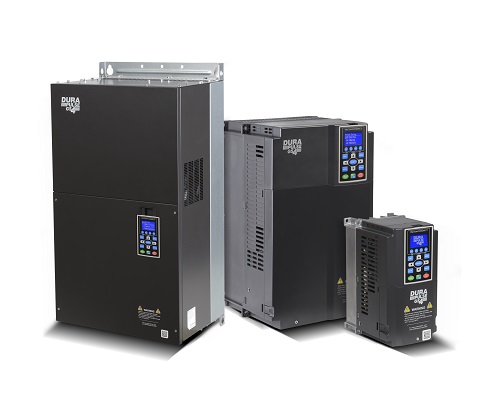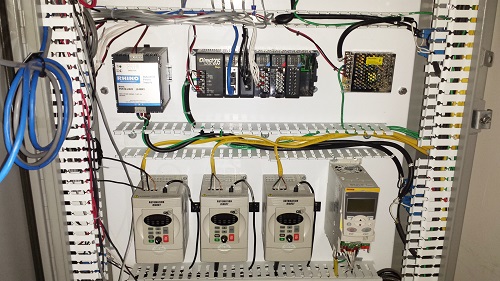When powering AC motors, the electrical supply can be at full power to run at full speed, or at variable power to run at variable speed. Applications with fluctuating loads benefit from the variable speed provided by an AC drive because less power is used at lower loads and speeds, and this article explains how an AC drive accomplishes this.
What are AC Drives?
An AC drive, also often referred to as a variable frequency drive or a VFD, is a power supply control and conditioning device for AC motors.
 These AutomationDirect DURApulse GS4 series AC inverters, also called AC drives or variable frequency drives, provide the frequency and voltage needed to drive an AC motor.
These AutomationDirect DURApulse GS4 series AC inverters, also called AC drives or variable frequency drives, provide the frequency and voltage needed to drive an AC motor.
Bryan Sisler, Product Manager for Drives and Motors at AutomationDirect, wrote an article for the May/June 2018 issue of InTech magazine titled Explaining AC Drives, which is summarized below.
Sisler explains that since AC motors require frequency to spin, the drive must provide the required energy waveform with enough voltage to provide the needed current to produce magnetic flux within the motor.
To produce this desired frequency waveform, an AC drive is provided with an AC voltage supply and rectifies it to DC voltage, normally through a diode bridge, or if a regenerative 4-quadrant drive, then through insulated-gate bipolar transistors (IGBTs). This rectified power is stored in a capacitor bank as part of a DC bus. This is known as the converting section of the drive.
The AC drive enables control of the operating characteristics of an AC motor, which can reduce energy used by the motor. This energy savings is through adjusting or limiting of the applied voltage and current during controlled acceleration/deceleration, and especially during normal operation.
AC Drive Applications
Sisler notes that AC drives can be found in many different applications:
Pumps, fans and conveyor applications alone can generate hundreds of applications. Even the terms within applications can be synonymous. Bulk conveying can be carried out with pumps, fans or conveyors—for instance. Application examples include tons of flour blown through pipes for a bagging operation, pumps handling tens of thousands of gallons of soda through a bottling line, conveyors moving coal or rock over miles of quarry, or a conveyor carrying thousands of cookies through a baking oven.
Best Practices for AC Drive Integration
Best practices for AC drives include a thorough review of the application. A properly selected motor type, with the rightsized motor and drive, are the starting point for any application, and this requires a detailed review of the load characteristics. Other items to consider are the nature of the energy supply to the drive, and the environment in which the system will operate. In some instances, an AC transformer and/or supply reactor may be needed to provide a clean source of power.
An installation review, including protection required from other energy consumers on the AC drive supply side, is necessary in many cases, and proper grounding systems are also needed. Finally, there must be adequate room for the AC drive and its protective devices. For example, the enclosure type and size must be sufficient to provide cooling, and protection from the environment.

Unless specifically rated for field mounting, AC drives, such as these AutomationDirect GS2 drive units, should be installed in a control cabinet to protect them from the environment, with proper spacing for cooling.
Sisler says a plan should also be created for programming of the AC drive to provide the connected motor with the best possible operational methodology and energy savings. Fortunately, many of the required capabilities are built into AC drives for this purpose.
In summary, Sisler notes:
From the simple air fan in the warehouse—to the complexity of energy storage systems, water supply or waste water management systems—AC motors running at variable speeds play a key role. Since AC motors consume much of the electricity generated worldwide, using AC drives to limit energy use can produce significant savings.
To read more articles about AC Drive or Motors, click here.

